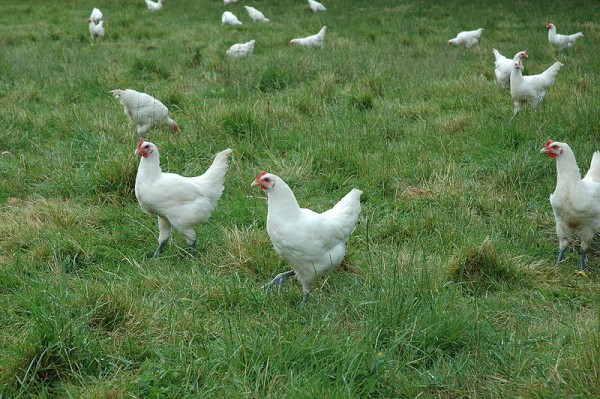
19 February 2014
In The Botany of Desire Michael Pollan remarks that the plants humans desire are more numerous and successful than those we don’t care about. Apples and potatoes would be overlooked plants, found only in their native ranges in Asia and South America, if we didn’t like to eat them.
This is also true of birds. Chickens were domesticated 8,000 years ago as a subspecies of the red junglefowl (Gallus gallus) of India and Southeast Asia. The result is a domestic chicken that comes in several colors, is barely able to fly, and is found around the world. As of 2019 their worldwide population was 25.9 billion. There are more chickens on earth than any other bird.
This is hard to imagine until you realize that 74% of ‘meat’ chickens and 68% of egg layers are raised by intensive farming methods, such as battery cages, where space per bird is minimized. Fortunately there is pressure to legislatively and voluntarily stop inhumane practices. The EU, for example, outlawed battery cages in 2012.
Meanwhile urban farming is picking up, even in the City of Pittsburgh. A couple of years ago I met a family of four hens who lived a few blocks from my Greenfield home. Though kept for their egg-laying and treated as pets I was impressed by their “bird-ness” and their pecking order. They were fascinating to watch.
Our desire for chickens and eggs insures these birds will always be the most numerous bird on earth.
(photo of Bresse chickens from Wikimedia Commons. Click on the image to see the original)
Yes! My eagle-eye caught those chickens on first appearance!
I saw your original post on this in January and would like to add that they are a real asset to homeowners because they eat ticks and mosquitos!
I saw it in January and never noticed that it disappeared. Until I read to the bottom I wondered why it was being repeated today.
Who’s eating House Sparrows? They have to be in the top 5. Maybe Rock Pigs too. ; )
Donna, Diane and Carla, only my most dedicated morning-time readers would ever have noticed — and they are you. Thank you for following my blog!
p.s. and Denise and Peggy, too
me too, me too.
Completely off the subject, but I just checked the Hays Bald Eagle nestcam, and there’s an egg! Does anyone know when it was laid?
Wow, Candy! I can hardly wait to get to my computer to check!
Candy, on Facebook Wild Bird Recovery says it was at 4:45pm
Thanks, Kate! So exciting! Maybe spring really is on the way!
Yes, I too saw the chickens the first time they appeared.
Thanks, Peggy.